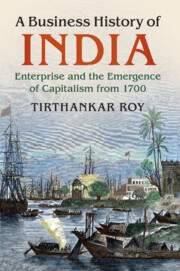Book contents
- A Business History of India
- A Business History of India
- Copyright page
- Dedication
- Contents
- Figures
- Maps
- Tables
- Boxes
- Preface
- 1 Introduction
- 2 The Baseline at 1700
- 3 The Indian Ocean Sphere: 1700–1850
- 4 Capital and Empire (1850–1930)
- 5 Capital and Empire (1850–1930)
- 6 State and Industrialisation: 1930–1950
- 7 State and Industrialisation: 1950–1980
- 8 Revival: 1980–2000
- 9 Capital and Globalisation: 2000–2015
- 10 Conclusion
- References
- Index
9 - Capital and Globalisation: 2000–2015
Published online by Cambridge University Press: 20 March 2018
- A Business History of India
- A Business History of India
- Copyright page
- Dedication
- Contents
- Figures
- Maps
- Tables
- Boxes
- Preface
- 1 Introduction
- 2 The Baseline at 1700
- 3 The Indian Ocean Sphere: 1700–1850
- 4 Capital and Empire (1850–1930)
- 5 Capital and Empire (1850–1930)
- 6 State and Industrialisation: 1930–1950
- 7 State and Industrialisation: 1950–1980
- 8 Revival: 1980–2000
- 9 Capital and Globalisation: 2000–2015
- 10 Conclusion
- References
- Index
Summary
In the wake of the economic reforms of 1992, there was a burst of investment and export, and the economy grew at 6–8 per cent per year for the next four years. In 1997, there was a sharp drop. Thereafter, for about six years, overall economic growth in India fluctuated a lot. The Asian economic recession contributed to the 1997 dip, but short-lived governments formed of unstable coalitions, with the communist parties as partners, contributed to the uncertainty. From 2002–3, the political situation stabilised. The prospects for the world economy improved, and Indian growth bounced back.
Some things changed between the years before the erratic growth phase and the years after. ‘Globalisation’ is a useful expression to summarise the changes, since both foreign trade and foreign investment played a bigger role during the latter years. Globalisation means different things to different people. It is necessary to make its use more precise here. I use ‘globalisation’ to mean the capacity to buy knowledge from the world. In the late nineteenth century, this capacity was created in India via export of textiles and agricultural commodities. In the middle years of the twentieth century and the Nehruvian pursuit of ‘heavy’ industry at any cost, the capacity was impaired. The companies making and selling textiles or agricultural goods, and companies with pre-existing contact with traders abroad, were damaged. From the turn of the twenty-first century, the capacity to buy knowledge abroad was regained by selling labour services and labour-intensive manufactures. This in turn enabled corporate firms to procure the know-how needed to make things for Indian buyers.
Business development is a macroeconomic balancing act because the process in India needs capital, knowledge, and some types of skills still in shortage in the country. Openness to trade and factor movements is an absolute necessity for macroeconomic balance. The balance was restored from the 1990s. The restoration was not all scripted by the state. India was lucky too. The huge fall in communication cost, and the maturing of the information technology revolution made services – traditionally not traded very much – more tradable throughout the world. Indian capital joined the movement as a supplier as well as a consumer. As it did, more money than before flowed from abroad into India, much of it going into the services.
- Type
- Chapter
- Information
- A Business History of IndiaEnterprise and the Emergence of Capitalism from 1700, pp. 240 - 255Publisher: Cambridge University PressPrint publication year: 2018



